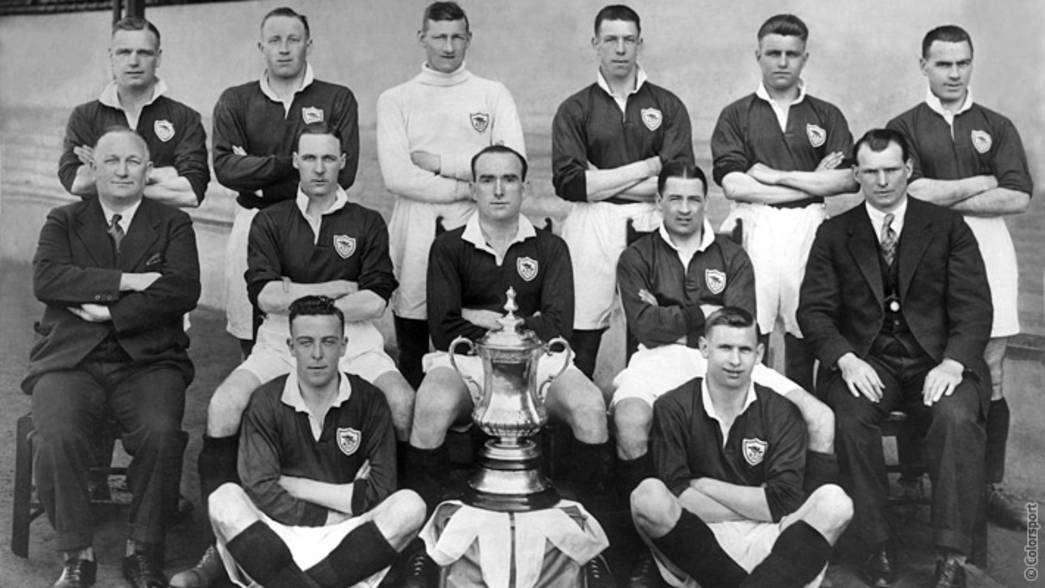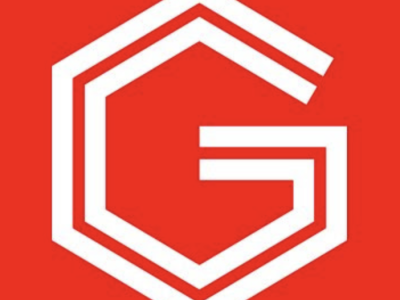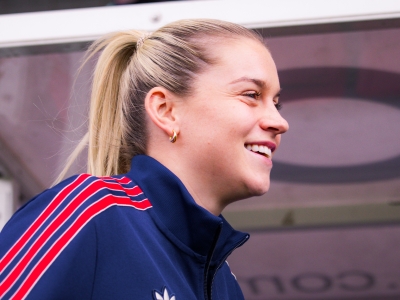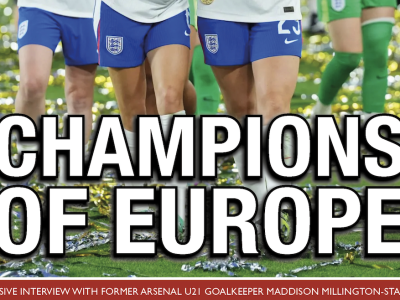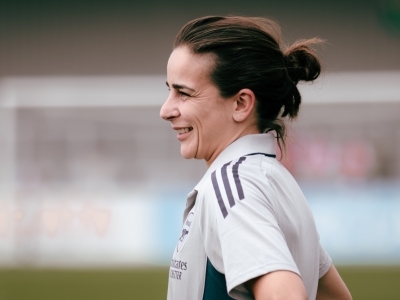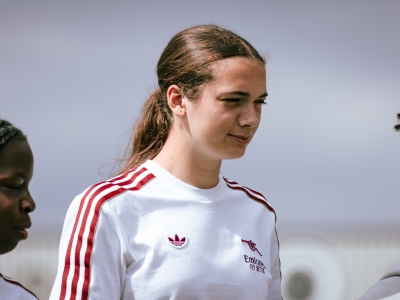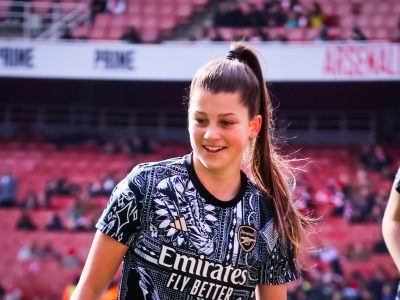On Saturday, Arsenal will appear in their record twenty first FA Cup Final – which along with their record number of thirteen FA Cup wins underlines the club’s position as the most successful side in the history of Football’s oldest, and most prestigious domestic knock out tournament. In honour of this feat, I will therefore run through a two-part special which includes all twenty-one finals, starting today with a special #ThrowBackThursday running through the pre-Premiership era of Arsenal’s cup final footage. Arsenal’s debut appearance came on April 23rd 1927 – at what was the fifty fifth F.A. Cup Final, though only the fourth to be played at what was then known as the Empire Stadium in Wembley.
Arsenal’s debut FA Cup Final appearance came on April 23rd 1927 – at what was the fifty fifth Final, though only the fourth to be played at what was then known as the Empire Stadium in Wembley. The final was also noteworthy as being the first to be broadcast by BBC Radio, with commentary performed by future Arsenal manager George Allison and children’s hour presenter and Larry the Lamb narrator Derek ‘Uncle Mac’ McCullough. The Corporation had been founded just a few months earlier by a Royal Charter, with one of the Public Service principles laid down by its original Director General – Lord Reith – being the promotion of a ‘National’ culture, with the FA Cup Final as a result elevated as an ‘event’ within the national consciousness.
The commentary for the 1927 FA Cup Final involved one commentator describing the action, while another called out what square the ball was in, on the basis of a grid which appeared in the Radio Times – allegedly where the phrase of being ‘Back to Square One’ originates from (an idea that anyone who has ever followed football via the Radio in the years since would probably ask why it was ever dropped as it sounds a pretty good way of following a game you cannot visually see!) Though the game took place on St. George’s Day, the slaying of Welsh dragons it seems was not to be on the agenda. Despite Scottish side Queen’s Park appearing in the 1884 and 1885 finals, this was to be the only time in its history that the FA Cup was to leave England. The final was to be long remembered for the howler dropped by Arsenal’s Welsh goalkeeper Dan Lewis, which led to Cardiff’s winner in a 0-1 defeat for Arsenal 0-1 defeat for Arsenal. However a far worse fate befell Cardiff goal scorer Hughie Ferguson who in 1930 was to take his own life due to depression, aged just 33.
Herbert Chapman’s Arsenal however were to return to Wembley again in 1930, against Herbert’s old side, Huddersfield Town. In honour of Chapman, both sides entered the field of play side by side – a Cup Final traditional which still continues to this very day. Seventeen minutes into the 1930 Final Alex James gave Arsenal the lead with a move involving a quickly taken free kick. In his time at Raith Rovers, north of the border, James had frequently performed this tactic as Scottish referees where more likely to permit it. In England he rarely got away with it and Herbert Chapman requested James to stop trying it. Luckily, James refused to follow orders and the move led to Arsenal’s first goal. After being brought down forty yards from goal, James’s quickly taken free kick brought a one-two with Cliff Bastin before James put away Arsenal’s opener.
Outside of being the first major trophy win for North London’s finest, the 1930 FA Cup Final was notable for the freak appearance of the German Graf Zeppelin airship – which at the time was the largest airship ever at around 776 ft. in length - hovering at 200 feet above Wembley Stadium. I’ve never found a sufficient explanation as to why the Graf Zeppelin appeared over Wembley that day, and so assume it to be a case of the Germans showing off their recent achievements in front of the Auld Enemy in order to secure maximum publicity. The Graf Zeppelin – which completed the fasted circumnavigation of the globe a year earlier – had been a rare source of inter-war pride for a German nation that over the dozen years prior to 1930 had suffered humiliation after the losing the First World War and their subsequent punishment imposed by the Treaty of Versailles.
Such was the noise emanating from the Zeppelin as it hovered above Wembley that the game was halted before the ship dipped its nose in salute of King George V (present at Wembley as the guest of honour) and promptly disappeared from view. Many Huddersfield Town fans blame this disturbance for halting their side’s momentum in finding a way back into the contest and ultimately, Jack Lambert was to add a second goal two minutes from time to secure an Arsenal victory. A great irony however, is that the pilot of the Graf Zeppelin that day was a man called Captain Ernst Lehmann – a whole seventy five years before his compatriot and namesake’s penalty saving heroics delivered Arsenal the FA Cup at Cardiff’s Millennium Stadium in the 2005 Final.
Two days on from winning the FA Cup, Arsenal received a guard of honour from a visiting Sunderland side to Highbury, a fixture which Arsenal lost 0-1. There may be many that might think that the playing of League fixtures on FA Cup Final day, or League fixtures which are played after the FA Cup Final are a modern aberration which fly in the face of tradition, however a programme of First Division fixtures were regularly played on FA Cup Final day right up until 1948, with the televising of the FA Cup Final being the main reason behind the Final being given its own day after the completion of League fixtures at the very end of the domestic Football Season. In his posthumously published autobiography, former Arsenal boss Tom Whittaker hailed the fixing of a special day for the FA Cup Final as a ‘step in the right direction’ and that ‘in the past it was estimated that gates dropped by 250,000 when the final was broadcast, and nearly as much again when it was televised’.
With victory in the 1930 FA Cup Final, the foundations were laid for Arsenal’s decade of domination. Twelve months on they became the first side south of Birmingham to win the Football League title and come the start of the 1931/32 season Arsenal’s ambitions were drawn to becoming the first side to pull off the League and FA Cup double – a feat which had proved elusive in English football since the introduction of the maximum wage and retain and transfer system in the 1890s – both measures which had aimed to prevent the top sides hoarding all of the Nation’s talented players (the double in fact wouldn’t be repeated again until the era of the abolition of both in the early 1960s).
Arsenal’s title push in 1932 however came off the rails as a result of injury to playmaker Alex James, which resulted in their failure to win six out of seven league games, which ultimately put paid to Arsenal’s title defence. As seen from this Pathe News footage (along along with some very 1930s humour from Joe Hulme, which may sound a bit suspect to 21st Century ears!) Tom Whittaker had worked around the clock to get Alex James fit, but ‘Wee Alec’ was forced to sit out the 1932 final. It turned out to be another ‘North v South’ affair, this time against Newcastle in what came to be known as the ‘over the line’ final, in which the Magpies cancelled out Arsenal’s lead with a disputed equaliser, going on to defeat Arsenal in the contest 1-2.
Arsenal’s next final came four years later in 1936, with a hat-trick of League title wins from 1933 to 1935 in between. However, due to a dispute between the newsreel companies and Wembley Stadium’s owner – Sir Arthur Elvin – only this bizarre footage of the 1936 FA Cup Final, involving aerial shots of the Wembley pitch captured by auto-giro aircraft flying over Wembley, exists. The essence of the dispute was that after the 1924 British Empire Exhibition, the FA Cup Final had been Wembley’s only regular event. Prior to the introduction of Greyhound Racing and Speedway, Wembley Stadium was beginning to very much look like a white elephant. In order to seek extra revenue from the FA Cup Final, Elvin had requested a figure of £1500 from newsreel providers - such as Pathe, Gaumont and Movietone News - who had never previously paid for the privilege of showing footage from the FA Cup Final within their respective cinema chains. Collectively they were only willing to offer just £500 and as a result found themselves barred from Wembley on Cup Final day.
On the day, Arsenal beat Sheffield United 1-0. The 1936 Final was to be Arsenal’s last before the outbreak of World War II, they were however to appear in two wartime Wembley finals. In 1941 Arsenal drew 1-1 with Preston North End, before losing the replay at Ewood Park 1-2. Two years later Arsenal were back at Wembley to defeat Jimmy Seed’s Charlton Athletic side 7-1 in the Southern area final, however were to lose 4-2 in the national final against northern cup winners, Blackpool. Their first post-war final was to come in 1950 against a Liverpool squad which included future manager Bob Paisley. Paisley however was dropped from the first eleven on Cup Final day, as Arsenal ran out 2-0 winners.
For Tom Whittaker’s side, one further Final was reached two years later against Newcastle United. As with their meeting twenty years earlier, Arsenal had been in the running again for that elusive double. However, after defeating Chelsea in the FA Cup Semi Final, Arsenal had to play eight league games in seventeen days in order to complete their league fixtures. Going into the game Arsenal had fitness worries, which were compounded when the Gunners lost Walley Barnes to injury after thirty five minutes and played the rest of the game with ten men, eventually losing 0-1 with a goal conceded six minutes from time.
That elusive double finally arrived with Arsenal’s next final, however it came after a nineteen year wait in 1971 (a three-part video series of with all available footage can be found here). The Cup Final winner came from a goal scorer who was still five months away from being born the last time Arsenal won the FA Cup – and also came against Liverpool with a 2-1 victory. The nineteen-year gap between FA Cup Finals however was more than made up for, as over the following nine years Arsenal were to appear in four further finals, starting with the centenary Cup Final a year later. However, there was to be no repeat of the heroics of 1971, as Leeds United bagged their first ever FA Cup with a 0-1 defeat for Arsenal, though Don Revie’s side ultimately failed in their own attempt at a League and FA Cup double, losing the League Championship to Brian Clough’s Derby County forty eight hours later with a 1-2 away defeat at Wolves.
Arsenal returned to Wembley again in 1977/78 (full footage of the season can be viewed here). Arsenal’s regular FA Cup Final appearances throughout the 1970s - viewed as they were by many across the world - were to bring the club a global profile, as shown from this Australian Television trailer for the 1978 FA Cup Final. That year’s final however was to prove disappointing as Ipswich took the Cup back to East Anglia with them after a 0-1 defeat for Arsenal. Despite the defeat, as shown by this season review for 1978/79, Arsenal would return to face Man United in the FA Cup Final the following year. This footage from the edition of TISWAS ahead of that year’s final showed somewhat of a Man United bias running through much of ITV’s coverage.
The exciting final four minutes has since passed into Football folklore, as portrayed here by Alan Sunderland sending up his old look on an episode of Fantasy Football League’s ‘Phoenix From The Flames’ strand back in the mid-1990s. The final instalment of Terry Neill’s Cup Final trilogy followed in 1980 at the end of a seventy game season (as told in full here), but sadly resulted in an anti-climax for an Arsenal side. The FA Cup Final came just ten days on from Arsenal’s fourth replay victory over Liverpool (granting Terry Neill even less time to prepare than Mikel Arteta gets this season). The final was won by a rare headed goal from Trevor Brooking, as for parodied here by Baddiel and Skinner in another ‘Phoenix from the Flames’.
The double defeat of 1980 was so traumatic that within a matter of days Joy Division lead singer Ian Curtis took his own life and he wasn’t even an Arsenal fan. Along with the departure of playmaker Liam Brady that same summer, it brought with it the end of an era for Arsenal, who never reached another final for the following seven years (as detailed in full by my video series ‘By Jesus Said Paddy’). Though George Graham brought trophy winning habits back to Highbury after his appointment in 1986, it would be another thirteen years on from the West Ham defeat before Arsenal would reach another FA Cup Final, which came during the first season of the ‘whole new ball game’ era of the FA Premier League, which will be elaborated on in my second instalment tomorrow.
*Follow me on Twitter@robert_exley
______________________________________
The current season's final issue of The Gooner (number 283) has been sent out to subscribers. We cannot sell this issue at matches, with fans banned from attending until next season, so for those who would normally buy it at the stadium, you can have it posted to you if you buy from our online store – UK addresses click this link, and overseas addresses click here. Or if you have a PayPal account you can simply send £6 (UK) or £7.50 (abroad) through our paypal.me link - https://www.paypal.me/goonerfanzine - but please remember to put you name and address in the ‘add note’ field

